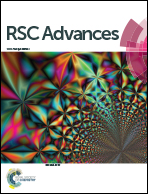Colorimetric detection of influenza A (H1N1) virus by a peptide-functionalized polydiacetylene (PEP-PDA) nanosensor†
Abstract
We developed a peptide-functionalized polydiacetylene (PEP-PDA) nanosensor for pandemic H1N1 virus (pH1N1) detection with the naked eye. A PDA nanosensor was fabricated by nano-precipitation and modified with PEP for the specific recognition of pH1N1. The PEP-PDA nanosensor showed unique chromatic properties involving a colour change from blue to red in the presence of pH1N1. We believe that this nanosensor can be applied for the development of a commercially available kit for pH1N1 detection.


 Please wait while we load your content...
Please wait while we load your content...